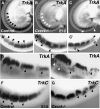CXCL12 signaling in the development of the nervous system
- PMID: 22270883
- PMCID: PMC4526243
- DOI: 10.1007/s11481-011-9336-x
CXCL12 signaling in the development of the nervous system
Abstract
Chemokines are small, secreted proteins that have been shown to be important regulators of leukocyte trafficking and inflammation. All the known effects of chemokines are transduced by action at a family of G protein coupled receptors. Two of these receptors, CCR5 and CXCR4, are also known to be the major cellular receptors for HIV-1. Consideration of the evolution of the chemokine family has demonstrated that the chemokine Stromal cell Derived Factor-1 or SDF1 (CXCL12) and its receptor CXCR4 are the most ancient members of the family and existed in animals prior to the development of a sophisticated immune system. Thus, it appears that the original function of chemokine signaling was in the regulation of stem cell trafficking and development. CXCR4 signaling is important in the development of many tissues including the nervous system. Here we discuss the manner in which CXCR4 signaling can regulate the development of different structures in the central and peripheral nervous systems and the different strategies employed to achieve these effects.
Figures





Comment in
-
The molecular basis for neuroimmune receptor signaling.J Neuroimmune Pharmacol. 2012 Dec;7(4):722-4. doi: 10.1007/s11481-012-9398-4. Epub 2012 Aug 31. J Neuroimmune Pharmacol. 2012. PMID: 22935971 Free PMC article.
Similar articles
-
Human Cytomegalovirus UL111A and US27 Gene Products Enhance the CXCL12/CXCR4 Signaling Axis via Distinct Mechanisms.J Virol. 2018 Feb 12;92(5):e01981-17. doi: 10.1128/JVI.01981-17. Print 2018 Mar 1. J Virol. 2018. PMID: 29237840 Free PMC article.
-
CXCL12-CXCR4/CXCR7 Axis in Colorectal Cancer: Therapeutic Target in Preclinical and Clinical Studies.Int J Mol Sci. 2021 Jul 9;22(14):7371. doi: 10.3390/ijms22147371. Int J Mol Sci. 2021. PMID: 34298991 Free PMC article. Review.
-
[Chemokines and defense-system cell homing].J Soc Biol. 2001;195(1):9-12. J Soc Biol. 2001. PMID: 11530508 Review. French.
-
CXC chemokine receptor 4 regulates neuronal migration and axonal pathfinding in the developing nervous system: implications for neuronal regeneration in the adult brain.J Mol Endocrinol. 2007 Mar;38(3):377-82. doi: 10.1677/JME-06-0032. J Mol Endocrinol. 2007. PMID: 17339400 Review.
-
Chemokine signaling in development and disease.Development. 2014 Nov;141(22):4199-205. doi: 10.1242/dev.101071. Development. 2014. PMID: 25371357 Free PMC article. Review.
Cited by
-
CXCL12-PLGA/Pluronic Nanoparticle Internalization Abrogates CXCR4-Mediated Cell Migration.Nanomaterials (Basel). 2020 Nov 20;10(11):2304. doi: 10.3390/nano10112304. Nanomaterials (Basel). 2020. PMID: 33233846 Free PMC article.
-
Diallyl Trisulfide Suppresses the Production of Lipopolysaccharide-induced Inflammatory Mediators in BV2 Microglia by Decreasing the NF-κB Pathway Activity Associated With Toll-like Receptor 4 and CXCL12/CXCR4 Pathway Blockade.J Cancer Prev. 2018 Sep;23(3):134-140. doi: 10.15430/JCP.2018.23.3.134. Epub 2018 Sep 30. J Cancer Prev. 2018. PMID: 30370258 Free PMC article.
-
Unraveling Neurodevelopment: Synergistic Effects of Intrinsic Genetic Programs and Extrinsic Environmental Cues.Adv Sci (Weinh). 2025 Jun;12(22):e2414890. doi: 10.1002/advs.202414890. Epub 2025 May 5. Adv Sci (Weinh). 2025. PMID: 40323170 Free PMC article. Review.
-
The role of CXCL12/CXCR4/CXCR7 axis in cognitive impairment associated with neurodegenerative diseases.Brain Behav Immun Health. 2024 Dec 24;43:100932. doi: 10.1016/j.bbih.2024.100932. eCollection 2025 Feb. Brain Behav Immun Health. 2024. PMID: 39834554 Free PMC article. Review.
-
Meninges: from protective membrane to stem cell niche.Am J Stem Cells. 2012 May 28;1(2):92-105. Print 2012. Am J Stem Cells. 2012. PMID: 23671802 Free PMC article.
References
-
- Alonso E, Gomez-Santos L, Madrid JF, Saez F. The expression of a novel cxcr4 gene in xenopus embryo. Histol Histopathol. 2009;24:1097–1103. - PubMed
-
- Bagri A, Gurney T, He X, Zou YR, Littman DR, Tessier-Lavigne M, Pleasure SJ. The chemokine SDF regulates migration of dentate granule cells. Development. 2002;129:4249–4260. - PubMed
-
- Bajetto A, Barbero S, Bonavia R, Piccioli P, Pirani P, Florio T, Schettini G. Stromal cell-derived factor 1 alpha induces astrocyte proliferation through the activation of extracellular signal-regulated kinases 1/2 pathway. J Neurochem. 2001a;77:1226–1236. - PubMed
Publication types
MeSH terms
Substances
Grants and funding
LinkOut - more resources
Full Text Sources
Other Literature Sources

